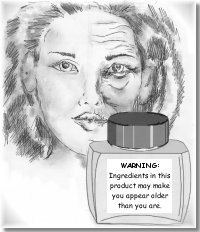
Consumers are concerned about long term effects of glycolic and other acids for the skin. E-mails and inquiries for the past few years show a varied interest in using safe products. Esthetician Pharmacology Research Institute (EPRI) has been educating and teaching scientific theory for care of one of the most visible organ of the body for more then three decades. Instruction is based on the knowledge and research of medical biochemist, Dr. Clyde Johnson. In his 27 years of research on the physiological effects of acid containing cosmetic products, he was unable to find any scientific reference to the beneficial use of glycolic acid or glycol containing solutions to skin. On the contrary, he found medical references defined glycolic acid as an irritant and toxic substance.
As stated in the Merck Index, An Encyclopedia of Chemicals and Drugs, glycolic acid is a constituent of sugar cane juice. It is "odorless, somewhat hygrosopic crystal…soluble in water, methanol, alcohol, acetone, acetic acid, ether." It is used "in the processing of textiles, leather and metals; in pH control, and wherever a cheap organic acid is needed, e.g. in the manufacture of adhesives, in copper brightening, decontamination cleaning, dyeing, electroplating, in pickling, cleaning and chemical milling of metals. CAUTION: Mild irritant to skin and mucous membranes."
In Dorland's Illustrated Medical Dictionary, glycol is identified as "useful as solvents and plasticizers." The dictionary goes on to state that "plasticizing" is regarded as the result of polymerization, in which an organic compound of high molecular weight is formed by chemically combining compounds of lower molecular weight, often by the elimination of water or other simple compounds. Because substances containing glycol are of higher molecular weight, they freeze or boil at lower and higher temperatures, which is why glycol is used as radiator antifreeze. Derivatives are used in extermination, furniture polishes, as solvents for printers ink, adhesives and pesticides, a stabilizer for latex paint, among other things.
Osha's Regulated Hazardous Substances states "glycol containing products are considered a Class I hazard." This means such substances may be fatal if ingested with "acute and chronic local toxicity" levels of 2-1 to skin, mucous membranes and eyes.
Recent inquiries reflect individuals using glycolic and other acid containing products, such as AHA, etc., use showed marked skin dysfunction. With the overuse or long term use skin thinned and appears translucent. Veins along with the blood well under the skin become more evident giving the skin a dark red, pink or "bluish" shinny appearance. Hardening of the skin can occur; skin becomes impervious to penetrating creams, oils or lotions. Conversely, toxins under the skin are unable to be expelled through normal skin respiration. Once toxins become trapped, further damage can occur to skin tissue; this can retard the development of underlining healthy skin to surface and interferes with the skin's regenerative capacity.
By definition, acid is a low pH solution. The lower the pH or the less diluted the stronger the acid. Low pH substances will harden organic material. When used in skin care preparations, acidic ingredients (e.g. glycol, Alpha Hydroxy, lactic acid) can leave acid residues if overused. Acid can change the natural pH of the skin. When skin cannot regenerate faster than the residue is being deposited and compounded, the result is an alteration of the natural pH of the skin and interferes with the normal functioning of the skin, eventually this can cause damage.
Because of the apparent adverse effects of acid containing skin care products EPRI has historically discouraged their use. Articles by the Federal Food & Drug Administration and European Commission support the belief that acid containing cosmetic products may not only disturb natural skin function but may actually advance the visible signs of aging by hyper-sensitizing skin to damaging sun rays and interfere with the natural replication of DNA.
Dr. Johnson left a legacy of scientific theory now taught by his wife and mentor Florence Johnson, R.C.I. at EPRI students are taught that each individual's body chemistry is different and exhibits different actions and reactions to any given product. As stated by Dr. Johnson, "skin exhibits a miraculous regenerative capacity if allowed to function as nature intended". To further discuss the use of glycolic and Alpha Hydroxy acids in cosmetics, corrective procedures, etc., please contact Florence Johnson, RCL, director and educator of Estheticians Pharmacology Research Institute, a continuous education center for the health and beauty professional. E-mail: info@fanie.com.
References: Merck Index, an Encyclopedia of Chemicals and Drugs / Dorland's Illustrated Medical Dictionary / OSHA's Regulated Hazardous Substances